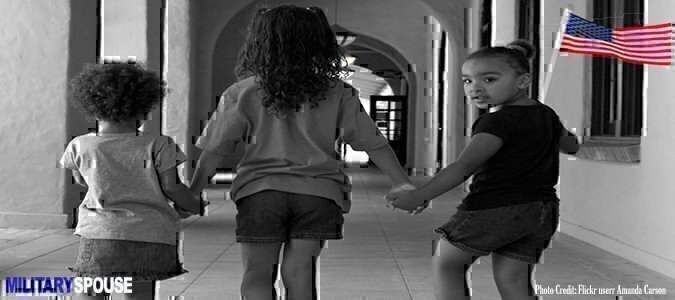However, if school districts are compensated for my children because they are deemed at some level of a financial burden (which I’m struggling to follow the logic), I expect schools to acknowledge them. There are some amazing teachers, principals, and staff across the country that “get” the lifestyle of military families – we don’t want to forget them because they have made a difference to our children. But, they are the diamonds in the rough.
Very few teachers and administrators who work in schools with military-connected children understand the needs and challenges of children of the uniformed services. Very few are exposed to the details of the federal compact between states called Military Children’s Interstate Compact Commission and why it’s been signed by all 50 states. Very few teachers and administrators understand how often our families move, or the affect war has on our children, or the crazy inequalities and variations of curriculum schools mandate in each state or even by each school district within a state. For the “extra” funding schools receive for our children, I expect them to know us.
There is a big push now due to recent findings by the Military Compensation and Retirement Modernization Commission to identify military dependent children. The report states, “Military dependent children experience unique stresses associated with parental deployments and frequent relocations that may adversely affect academic performance. At least 12 states have implemented, or are in the process of implementing, a military dependent student identifier, but inconsistencies in current implementations are introducing reporting errors.”
Also, in a recent study from the University of Southern California Department of Social Work recommend designating military dependent children as a specific cultural group – similar to children living below the poverty line and children with disabilities. For both of those categories, schools receive federal funding for as well. Children of military families will become a subset group tracked by the federal government. Why? It’s due to the unique stressors placed on our families through decades of war in hopes to create ways to better understand and support them.
I won’t go into the trivial details of Federal Impact Aid; there are pages and pages to digest. However, I will tell you there four categories school districts can apply for, but most schools pick the “unrestricted” category. There is funding for a military – connecting special needs children and capital improvement projects – but schools have to account for that spending and are restricted to what the funds can be used for.
Come this fall, your child’s school will ask you to fill out a federal survey and beg you to complete it by checking the box that says you are federally connected family. This is the money survey; all funding is based on returning these surveys back to the district so they can calculate our numbers and how much funding they are able to apply for us.
Fairfax County School District in Virginia, a larger federally impacted school, receives $3 million yearly in Impact Aid for federally connected children (uniformed service, DoD civilians, and those who live on federal land). Beavercreek School District near Dayton OH, a small school district comparatively, receives approximately $400,000 annually for nearly 900 federally connected students, making up 12% of the student population.
These school districts spend Impact Aid on whatever they desire – teachers salaries, chalkboards, after school or band programs, new basketballs or pencils – who knows what they spend it on, it doesn’t have to be reported or accounted for, it’s unrestricted spending.
I don’t mean to single our Fairfax County and Beavercreek; the statement above applies to every school that receives funding. I can name a hundred schools that have received aid – but I can’t find the amount they’ve received easily. The funding amount and which schools received funding are not listed anywhere – no where. You really have to find a needle in a hay stack. Luckily, I like finding needles.
It should be more transparent and accessible – truthfully, once the payments are made to the schools, amounts should be listed on the www.ED.gov site for all to review.
I’m not asking for special treatment for my military dependent child. Ok, well, maybe I am – but it’s not treatment of our children, it’s an understanding of them. I’m asking for acknowledgment for the unique needs they have from the schools. I’m asking for a little support from the schools that receive funding for our children. I’m looking for at least a nod or awareness that our children do have unique stressors when relocating or going through a deployment or parent injury. Studies have shown time and time again that having positive school experience for military dependent children can ease the stress of relocation and deployments.
There are schools who connect better with military families than others. Districts like Fairfax County Public School and San Antonio Independent School District are ones that do a good job integrating military-connected students into the school. But, they are exception not the rule. And for $3 million a year, I expect them to be well versed in military families.








